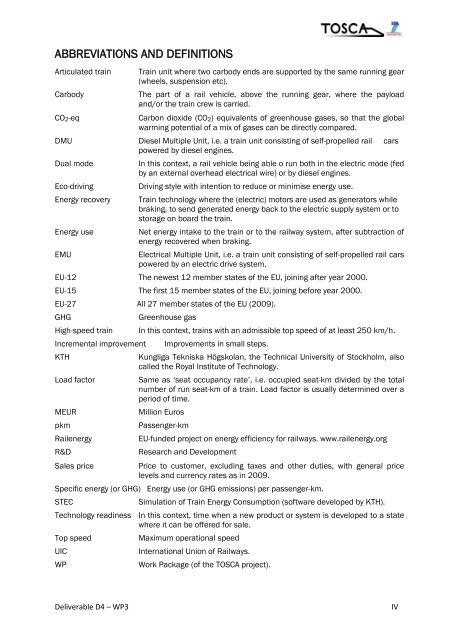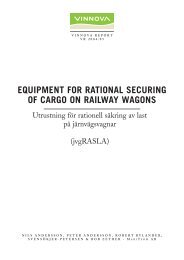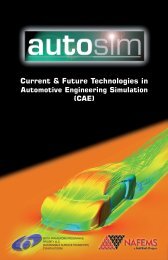WP3: Rail Passenger Transport - TOSCA Project
WP3: Rail Passenger Transport - TOSCA Project
WP3: Rail Passenger Transport - TOSCA Project
You also want an ePaper? Increase the reach of your titles
YUMPU automatically turns print PDFs into web optimized ePapers that Google loves.
ABBREVIATIONS AND DEFINITIONS<br />
Articulated train<br />
Carbody<br />
Train unit where two carbody ends are supported by the same running gear<br />
(wheels, suspension etc).<br />
The part of a rail vehicle, above the running gear, where the payload<br />
and/or the train crew is carried.<br />
CO2-eq<br />
Carbon dioxide (CO2) equivalents of greenhouse gases, so that the global<br />
warming potential of a mix of gases can be directly compared.<br />
DMU Diesel Multiple Unit, i.e. a train unit consisting of self-propelled rail cars<br />
powered by diesel engines.<br />
Dual mode<br />
In this context, a rail vehicle being able o run both in the electric mode (fed<br />
by an external overhead electrical wire) or by diesel engines.<br />
Eco-driving<br />
Driving style with intention to reduce or minimise energy use.<br />
Energy recovery Train technology where the (electric) motors are used as generators while<br />
braking, to send generated energy back to the electric supply system or to<br />
storage on board the train.<br />
Energy use<br />
Net energy intake to the train or to the railway system, after subtraction of<br />
energy recovered when braking.<br />
EMU<br />
Electrical Multiple Unit, i.e. a train unit consisting of self-propelled rail cars<br />
powered by an electric drive system.<br />
EU-12 The newest 12 member states of the EU, joining after year 2000.<br />
EU-15 The first 15 member states of the EU, joining before year 2000.<br />
EU-27 All 27 member states of the EU (2009).<br />
GHG<br />
Greenhouse gas<br />
High-speed train In this context, trains with an admissible top speed of at least 250 km/h.<br />
Incremental improvement Improvements in small steps.<br />
KTH<br />
Kungliga Tekniska Högskolan, the Technical University of Stockholm, also<br />
called the Royal Institute of Technology.<br />
Load factor<br />
Same as ‘seat occupancy rate’, i.e. occupied seat-km divided by the total<br />
number of run seat-km of a train. Load factor is usually determined over a<br />
period of time.<br />
MEUR<br />
Million Euros<br />
pkm<br />
<strong>Passenger</strong>-km<br />
<strong>Rail</strong>energy<br />
EU-funded project on energy efficiency for railways. www.railenergy.org<br />
R&D<br />
Research and Development<br />
Sales price<br />
Price to customer, excluding taxes and other duties, with general price<br />
levels and currency rates as in 2009.<br />
Specific energy (or GHG) Energy use (or GHG emissions) per passenger-km.<br />
STEC<br />
Simulation of Train Energy Consumption (software developed by KTH).<br />
Technology readiness In this context, time when a new product or system is developed to a state<br />
where it can be offered for sale.<br />
Top speed<br />
Maximum operational speed<br />
UIC<br />
International Union of <strong>Rail</strong>ways.<br />
WP<br />
Work Package (of the <strong>TOSCA</strong> project).<br />
Deliverable D4 – <strong>WP3</strong><br />
IV
















